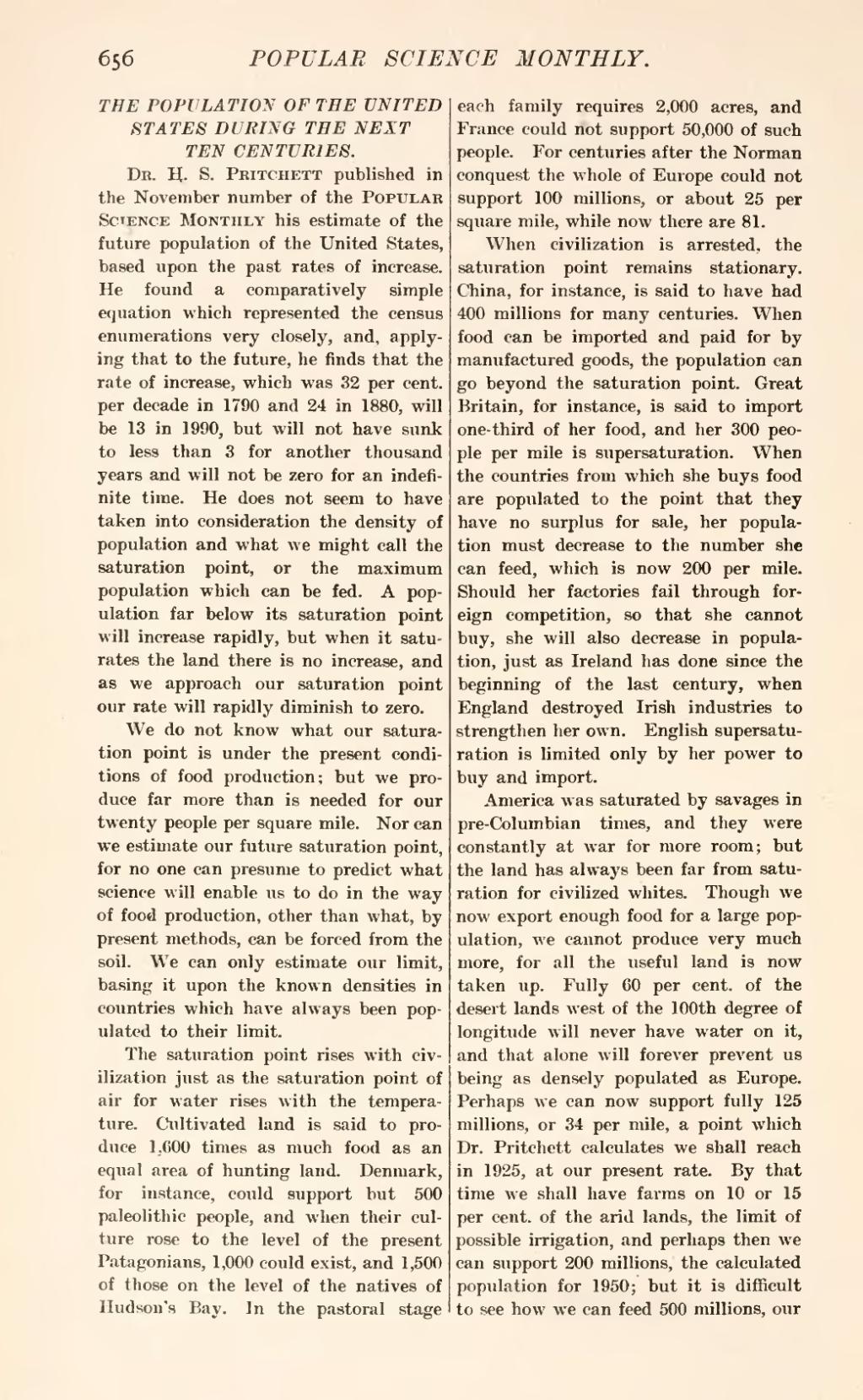THE POPULATION OF THE UNITED STATES DURING THE NEXT TEN CENTURIES.
Dr. H. S. Pritchett published in the November number of the Popular Science Monthly his estimate of the future population of the United States, based upon the past rates of increase. He found a comparatively simple equation which represented the census enumerations very closely, and, applying that to the future, he finds that the rate of increase, which was 32 per cent, per decade in 1790 and 24 in 1880, will be 13 in 1990, but will not have sunk to less than 3 for another thousand years and will not be zero for an indefinite time. He does not seem to have taken into consideration the density of population and what we might call the saturation point, or the maximum population which can be fed. A population far below its saturation point will increase rapidly, but when it saturates the land there is no increase, and as we approach our saturation point our rate will rapidly diminish to zero.
We do not know what our saturation point is under the present conditions of food production; but we produce far more than is needed for our twenty people per square mile. Nor can we estimate our future saturation point, for no one can presume to predict what science will enable us to do in the way of food production, other than what, by present methods, can be forced from the soil. We can only estimate our limit, basing it upon the known densities in countries which have always been populated to their limit.
The saturation point rises with civilization just as the saturation point of air for water rises with the temperature. Cultivated land is said to produce 1,600 times as much food as an equal area of hunting land. Denmark, for instance, could support but 500 paleolithic people, and when their culture rose to the level of the present Patagonians, 1,000 could exist, and 1,500 of those on the level of the natives of Hudson's Bay. In the pastoral stage each family requires 2,000 acres, and France could not support 50,000 of such people. For centuries after the Norman conquest the whole of Europe could not support 100 millions, or about 25 per square mile, while now there are 81.
When civilization is arrested, the saturation point remains stationary. China, for instance, is said to have had 400 millions for many centuries. When food can be imported and paid for by manufactured goods, the population can go beyond the saturation point. Great Britain, for instance, is said to import one-third of her food, and her 300 people per mile is supersaturation. When the countries from which she buys food are populated to the point that they have no surplus for sale, her population must decrease to the number she can feed, which is now 200 per mile. Should her factories fail through foreign competition, so that she cannot buy, she will also decrease in population, just as Ireland has done since the beginning of the last century, when England destroyed Irish industries to strengthen her own. English supersaturation is limited only by her power to buy and import.
America was saturated by savages in pre-Columbian times, and they were constantly at war for more room; but the land has always been far from saturation for civilized whites. Though we now export enough food for a large population, we cannot produce very much more, for all the useful land is now taken up. Fully 60 per cent, of the desert lands west of the 100th degree of longitude will never have water on it, and that alone will forever prevent us being as densely populated as Europe. Perhaps we can now support fully 125 millions, or 34 per mile, a point which Dr. Pritchett calculates we shall reach in 1925, at our present rate. By that time we shall have farms on 10 or 15 per cent, of the arid lands, the limit of possible irrigation, and perhaps then we can support 200 millions, the calculated population for 1950; but it is difficult to see how we can feed 500 millions, our
